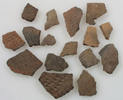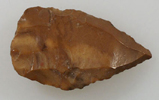|
The Neolithic Period
Thousands of years ago, seasonal lakes and savanna made central
Sudan a rich environment supporting a large population ranging
across what is now barren desert, like the Wadi el-Qa'ab.
By the middle of the 5th millennium BC, Nubia's Neolithic
peoples were full participants in the "agricultural revolution,"
living a settled lifestyle with domesticated plants and animals.
Rock art of cattle like that found during our expedition
suggests the presence of a cattle cult like those found in
the Sudan and other parts of Africa today.

| Pottery of the Neolithic was made from sandy clay and
decorated with distinctive rocker-stamped designs. |
Other finds include groundstone, which was used for making
flour, Ostrich eggshell, reflecting a tasty meal or perhaps
the raw material for bead making, and flint tools.
Before the discovery of metalworking, stone was the only
material available for making knives, projectile points, and
scythe blades for harvesting crops.

| The tip of a fine bifacially flaked spear point or arrowhead
came from el-Kab. |
|
